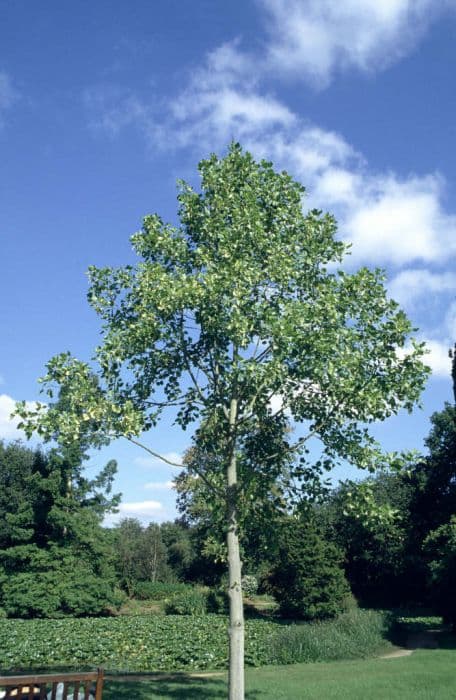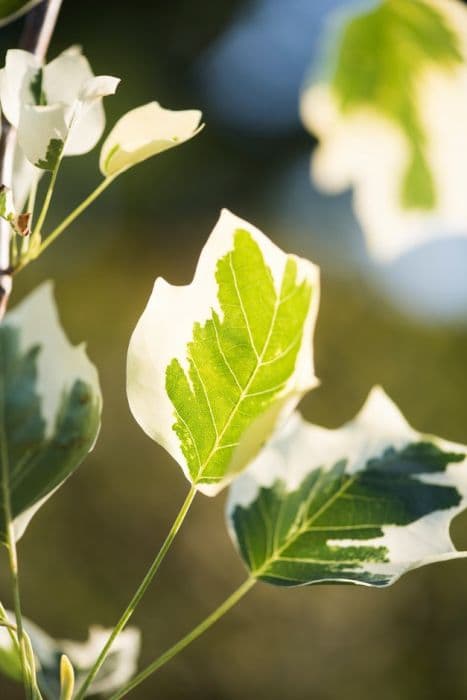Southern Magnolia Magnolia grandiflora 'Goliath'

ABOUT
The Magnolia grandiflora 'Goliath' is an elegant and splendid plant commonly known as the Southern Magnolia. It has an evergreen nature that contributes to its stately presence throughout the year. The most prominent and captivating feature of 'Goliath' is its magnificent flowers. The blooms are large, creamy-white, and possess a waxy, glossy texture with a rich, intoxicating fragrance that is often described as lemony or citrus-like. These alluring flowers, which appear in spring and summer, can be particularly showy, creating a romantic and almost opulent display. The leaves of the Southern Magnolia 'Goliath' are equally impressive, being leathery and dark green with a shiny, polished surface on the top, while the underside is a contrasting velvety rust-brown, with a fine fuzz that gives them a soft texture. The overall shape of the leaves is broad and oblong with a tendency to taper to a point. Seasonally, the Southern Magnolia 'Goliath' produces cone-like seed pods. These interesting seed pods open to reveal bright red seeds that add another layer of visual interest to the plant and can attract birds and wildlife to the garden. The bark of this plant is smooth and gray, providing a gentle backdrop that allows the glossy leaves and radiant flowers to stand out even more prominently.
About this plant
 Names
NamesFamily
Magnoliaceae.
Synonyms
Southern Magnolia, Bull Bay, Evergreen Magnolia, Large-flowered Magnolia, Big Laurel.
Common names
Magnolia grandiflora 'Goliath'.
 Toxicity
ToxicityTo humans
The Southern magnolia is not considered toxic to humans. However, as with many plants, individual allergies or sensitivities might cause mild irritation if the plant is handled or ingested. There are no well-documented cases of poisoning from ingesting parts of the Southern magnolia, so it is generally considered safe in terms of toxicity.
To pets
Southern magnolia is also not known to be toxic to pets. It is not listed as a poisonous plant for animals such as dogs and cats. If a pet were to ingest a large amount of the plant material, they might experience mild gastrointestinal upset due to the non-digestible nature of the plant fibers, but there is no specific toxin in the plant that would cause poisoning in pets.
 Characteristics
CharacteristicsLife cycle
Perennials
Foliage type
Evergreen
Color of leaves
Dark green
Flower color
White
Height
60 80 feet (18 24 meters)
Spread
35 50 feet (10.7 15.2 meters)
Plant type
Tree
Hardiness zones
7 10
Native area
Southeastern United States
Benefits
 General Benefits
General Benefits- Large, showy flowers: The Southern Magnolia 'Goliath' boasts large, fragrant, creamy-white flowers that can be a stunning addition to any landscape.
- Evergreen foliage: With glossy, thick, dark green leaves, 'Goliath' provides year-round interest and privacy screening.
- Shade provision: Its dense canopy can offer a cool respite on hot summer days, making it an excellent shade tree.
- Wildlife attractant: The flowers provide nectar for pollinators, while the seeds are a food source for birds.
- Aesthetic appeal: Its majestic form and impressive size make 'Goliath' a focal point in gardens, contributing to the overall landscape design.
- Durability: The Southern Magnolia 'Goliath' is known for its resistance to pests and diseases, which makes it a low-maintenance choice for gardeners.
- Longevity: Magnolias are long-lived trees, often gracing landscapes for generations.
- Noise reduction: The dense foliage can help to dampen noise pollution, creating a more tranquil outdoor space.
 Medical Properties
Medical PropertiesThis plant is not used for medical purposes.
 Air-purifying Qualities
Air-purifying QualitiesThis plant is not specifically known for air purifying qualities.
 Other Uses
Other Uses- Magnolia grandiflora 'Goliath' leaves can be used as a natural leather polish due to their waxy coating, which provides a shiny finish when rubbed onto leather surfaces.
- The hardy wood of the Southern Magnolia is sometimes utilized in furniture making, cabinetry, or veneer for its density and smooth grain.
- Its large, sturdy leaves are traditionally used in the South for elegant holiday decor, such as wreaths and garlands during the Christmas season.
- The blooming flowers provide a natural, subtle fragrance that can be used to infuse sachets or potpourri blends for home scenting.
- Dried magnolia seed pods create an interesting texture and shape for crafting, often used in flower arrangements or as part of decorative centerpieces.
- The bark of the Southern Magnolia can be utilized in small-scale landscaping as a rustic mulch or ground cover, enriching soil as it decomposes.
- Significant amounts of Southern Magnolia leaves may be used to create a natural dye, yielding a greenish-brown color for fabrics or artisanal crafts.
- The durable, glossy leaves can serve as creative plating for culinary presentations, particularly in outdoor or nature-inspired events.
- Photographers and artists commonly use Southern Magnolia as a picturesque subject or as a backdrop due to its grandeur and evergreen beauty.
- The seeds from the cones can be collected and used for crafting jewelry such as necklaces or earrings, creating a unique botanical aesthetic.
Interesting Facts
 Feng Shui
Feng ShuiThe Southern Magnolia is not used in Feng Shui practice.
 Zodiac Sign Compitability
Zodiac Sign CompitabilityThe Southern Magnolia is not used in astrology practice.
 Plant Symbolism
Plant Symbolism- Perseverance: The 'Goliath' cultivar of Magnolia grandiflora, also known as Southern magnolia, can withstand harsh conditions, symbolizing the ability to endure and persist.
- Dignity: With its large, showy flowers, the Southern magnolia is often associated with a stately beauty and a dignified presence.
- Nobility: Magnolias have been connected with nobility due to their association with ancient royal gardens and their regal appearance.
- Femininity: The magnolia's delicate and fragrant blooms are frequently used to represent femininity and grace.
- Love of Nature: The grand stature and evergreen leaves of the Southern magnolia exemplify a deep appreciation for the natural world and its beauty.
- Hospitality: In the American South, the Southern magnolia is a symbol of warm hospitality, welcoming others with its openness and fragrance.
 Water
WaterThe Southern Magnolia should be watered deeply and thoroughly, giving it 1-1.5 gallons of water every 7 to 10 days during its growing season, depending on the soil type and weather conditions. In hot, dry periods, you may need to water more frequently, ensuring the soil remains moist but not soggy. During the winter, reduce the amount of water as the plant requires less moisture when dormant. Make sure to water the base of the tree directly, avoiding wetting the leaves to reduce the risk of fungal diseases. Adjust your watering routine as necessary to meet the needs of your specific environment.
 Light
LightSouthern Magnolias thrive in full sun to partial shade locations. They need at least 4 hours of direct, unfiltered sunlight each day, but they will also benefit from some shade during the hottest part of the afternoon, especially in warmer climates. The best spot for a Magnolia grandiflora 'Goliath' is where it can receive morning sun and afternoon shade to protect its large, glossy leaves from excessive heat stress.
 Temperature
TemperatureSouthern Magnolias prefer temperate climates and can tolerate a temperature range from 20°F in the winter to 100°F in the summer. They do best in areas where the average temperature falls between 70°F and 90°F during the growing season. Ensure that you plant your Magnolia grandiflora 'Goliath' in a location where it's protected from harsh winter winds and severe frost.
 Pruning
PruningPrune Southern Magnolias to shape the tree, remove dead or damaged branches, and encourage healthy growth. The best time to prune is after the tree has finished flowering, typically in late spring or early summer. This minimizes the loss of next year's blooms. Pruning should be done sparingly, as too much can stress the tree. Always make clean cuts at a 45-degree angle just above a leaf node or branch to encourage proper healing.
 Cleaning
CleaningAs needed
 Soil
SoilSouthern Magnolia prefers rich, well-drained soil with a pH of 5.0 to 6.5. An ideal soil mix can be made of equal parts loamy soil, peat moss or compost, and perlite to ensure adequate drainage and aeration.
 Repotting
RepottingSouthern Magnolias, being large trees, are not typically repotted. Instead, they should be planted in the ground where they have space to grow. If grown in containers, they may need repotting every 3-5 years.
 Humidity & Misting
Humidity & MistingSouthern Magnolia thrives in moderate to high humidity levels. It is tolerant of the natural humidity found outdoors in its growing regions, without the need for additional humidity control.
 Suitable locations
Suitable locationsIndoor
Ensure bright, indirect light and large space.
Outdoor
Plant in full sun to part shade, sheltered from wind.
Hardiness zone
7-10 USDA
 Life cycle
Life cycleThe life of a Southern magnolia 'Goliath' begins with the germination of seeds, which occurs in ideal conditions of warmth and moisture. Once the seedling emerges, it enters a juvenile phase characterized by rapid growth and the development of its iconic glossy, evergreen leaves. In its maturation phase, which can take several years, the tree establishes a sturdy trunk and begins to produce its large and fragrant white flowers typically in late spring or early summer. After flowering, the plant enters its reproductive phase, developing cone-like fruit with bright red seeds that are dispersed by wildlife. As a perennial, the Southern magnolia 'Goliath' can continue to grow and reproduce for 80 years or more, given proper care and conditions. Eventually, it reaches its senescence stage, where growth slows, and the tree may become more susceptible to diseases or environmental stresses, leading to its decline and death.
 Propogation
PropogationPropogation time
Early Spring
The Southern Magnolia or Magnolia grandiflora 'Goliath' is commonly propagated through semi-hardwood cuttings, a method that is most effective when performed in summer when the plant's growth is actively underway. To propagate by cuttings, one should select a healthy, non-flowering shoot and cut a section that is about 6 to 8 inches (15 to 20 centimeters) long, ensuring it has several leaves. The bottom leaves are stripped away, and the cut end is dipped in rooting hormone to encourage root growth. The cutting is then placed in a well-draining potting mix, ensuring that the leaf nodes where the leaves were removed are buried in the soil. The pot should be kept moist and in a warm, indirect light until roots develop, which can be verified by a gentle tug on the cutting to feel resistance. It is essential not to disturb the cutting too much during the rooting period.









